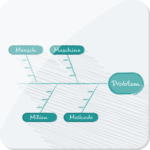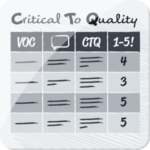
6-3-5
The 6-3-5 method is a creativity tool which is used to generate ideas and find solutions to a clearly defined problem. 6 participants write down 3 ideas each on a sheet of paper in a given time (for example one minute). The sheet is passed to the next participant who is doing the same. In total, the sheet of paper is passed 5 times.

Affinity diagram
How to structure and visualise ideas and/or areas of activity collected during a brainstorming session.

Cause and effect diagram
The cause and effect diagram (also named: Ishikawa diagram) is a classic tool in quality management and is applied for the determination of potential causes for a particular problem.

Cost-benefit-analysis
The cost-benefit-analysis (CBA) serves to monetarily rate one or more solutions in order to create a basis for the decision whether to implement a measure resp. the selection out of several alternatives. Thereby, cost and benefit are descripted in monetary units.

CTQ-Table
CTQ is a service or product feature that satisfies the key requirements of a customer. Single CTQs are summarized in the CTQ-Table. This table is partially based on the VOC plan.
CTQ = Critical to quality
VOC = Voice of customer

Customer needs table
The customer needs table is a tool used to identify the fundamental customer needs and it is often apllied during Six-Sigma projects. Customer statements are being transferred into the customer needs table in order to derive the fundamental needs a product or a process result should meet.

Data collection plan
The data collection plan serves as a tool to display structured requirements designed for the data collection considering the measurands for the data material and to display the specified measurements, processes and responsibilities for the implementation/execution of the measurements.

Evaluation grid
Tool for assessing different approaches to a problem providing a basis to make decisions and make them transparent to externals.

Feedback discussion
The feedback discussion is an effective communication and management method. It consists of the conversation between two people. The conversation reflects to the feedback partner, how its performance and behavior are perceived. Feedback consists of the two elements of giving feedback and receiving feedback.

Fishbowl (also: inner-/outer circle method)
In an inner circle a question is discussed, while participants in the outer circle listen. The participants of the outer circle can switch into the inner circle to join the discussion.
